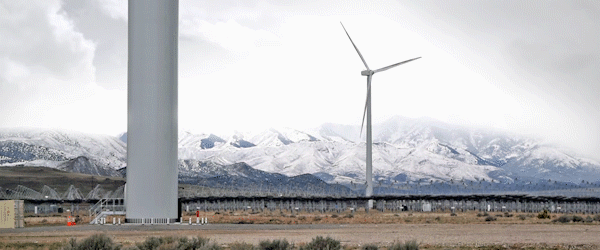By John Prettyman
U.S. Army Corps of Engineers, Sacramento District
SACRAMENTO, Calif. – A second wind turbine now towers nearly 300 feet above the rugged landscape of Utah’s Tooele Army Depot, part of a rapidly growing sustainable energy network constructed by the U.S. Army Corps of Engineers, Sacramento District.

Tooele’s first wind turbine (right) has been
generating power since 2010. The second turbine (left) will go online late 2016.
The $6.5 million wind turbine project is scheduled to be complete later this year and will generate almost 2 megawatts of power, enough to power 500-550 homes. Combined with the existing wind turbine completed in July 2010, both turbines will generate nearly 60 percent of the depot’s energy needs.
Civil Engineer Wes James explains the Corps’ renewable
energy projects at Tooele.
“The most fun part of this project was when they actually stood up the turbine,” said Wes James, civil engineer for the Sacramento District. “The coordination that it took to lift the turbine as one unit was extremely fascinating.”
Tooele’s energy plans don’t stop there. A nearby 1.5 megawatt solar array, consisting of 429 Stirling engine solar dishes spread across 15 acres, is scheduled to be fully operational in 2017.
.jpg)
A second wind turbine towers nearly 300 feet above the
nearby Stirling solar array at Tooele Army Depot, Utah. More photos
When the new turbines, solar array, backup generators, battery storage systems, a micro grid and other planned renewable sources are operational, Tooele expects to become net zero by 2020 – going off grid and producing all of its own energy needs.

Hi-res image
The Corps’ work at Tooele is part of the Army’s Energy Conservation Investment Program and is designed to increase renewable energy consumption on military installations, ultimately providing an environmental and tactical benefit.
The U.S. Army Corps of Engineers partnership with Tooele Army Depot constructing renewable energy projects will one day allow the ammunition storage installation’s crucial operations to continue unburdened by traditional power grid failures or black outs.